#QUICK RATIO EXAMPLE
Text
Quick Ratio
This post will take a dive into the concept of the quick ratio and its interpretation, along with an example.
The quick ratio, commonly referred to as the acid-test ratio, measures the ability of a business to pay its short-term liabilities using only the current assets that are readily convertible into cash. These “quick” assets are mainly cash and cash equivalents, marketable securities, and accounts receivable.
0 notes
Note
my guess would be that polls... seem less risky? like, it's automatically anonymous, it's less commitment (it's right there for you to click! you don't have to go looking for the ask button, put it on anon, then think about what to say - and since you're not saying anything, you don't risk saying something silly or offensive) and clearly you're not being a bother to OP, because they're definitely looking for interaction (well, at least that's why -i- often back out of sending asks...)
that's fair, and i certainly can see that for asks - the culture shift on tumblr definitely goes both ways with users not expecting to receive asks much anymore, too. (though, for the record, my ask box is always open, i really do like this style of engagement tumblr has, it's fun!)
but tbh i was talking way more about the other more traditional engagement aspects, not the actual action of voting in the poll:
that poll post currently has more reblogs than likes, which is awesome!! tumblr literally lives and dies by people reblogging stuff so it can show up on other people's dashboards. but the past couple years have seen a really steep decline in people reblogging things in general. in old tumblr culture, the ratio of likes to reblogs was generally 1:1 - you liked it and then you reblogged it so other people could see and like it. these days, since people are so used to other social media apps where liking something is "enough" for it to show up in an algorithm for someone else, the ratio has shifted so there are generally many more likes than reblogs on something :<
i do think there might also be an argument to make something of the lines of "i think a lot more people are looking for a lot more interaction on posts than people assume, especially artists and writers and editors and any other sort of person who puts time and effort into the things they post online," but that's probs a bit off topic... ヾ(•ω•`)o
anyway tldr i was just surprised to see that the poll was engaged with in ways old tumblr culture used to be in terms of the number and types (larger number of people leaving notes in the tags) of reblogs n stuff!
#there's some really interesting statistic based posts out there regarding reblog / like ratios from different tumblr eras too!#but quick example the other post i made today (a svsss shitpost meme) currently has a like : reblog ratio of about 3:1#but uh dkfjh yea i was just kinda excited to see that polls are a kind of post that tumblr gives the old “spread far and wide” treatment!#maybe due to the way people often ask for reblogs for sample size on their polls?#maybe everyone should just start doing that for every kind of post then dfgjfd#“please reblog for larger sample size of how funny my joke is / how good my art is / etc” dfghfjdkg
1 note
·
View note
Note
Hi! 😁 I might soon have the chance to have a garden and I've always wanted to have a few chickens, and I've started some online reasearch about keeping chickens but since you're an expert and I don't trust some of the online sources, do you have any tips for absolute beginners? 😅
I do! You can have a garden, or you can have chickens, but the two are diametrically opposed forces that do not coexist peacefully without fully enclosing one or the other. Chickens can and will obliterate gardens and landscaping if they have access to it, including absolutely destroying mulch patches by helping you spread it all over the yard.
I'll put the rest under a cut ^_^
When you acquire chickens, don't get them from a hatchery, get them from a small breeder you've looked into and spoken with about their actual birds. Hatcheries have poor quality animals, so while you may be getting a "black copper marans," they're not gonna necessarily look very nice, and they're almost certainly not going to lay that nice, deep chocolate marans are known for.
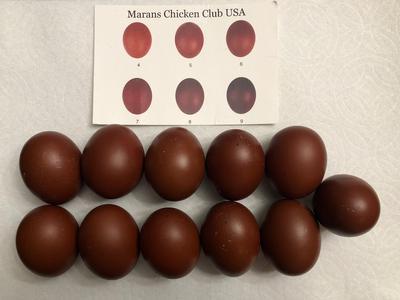
Vs straight from one of the bigger hatcheries pages, photos of their eggs:

You also are NOT going to get the breed qualities of any given breed except maybe some of the production breeds. For example, a Jersey Giant from a reputable breeder will get up to 10-13lbs, which is as big or bigger than my peafowl. Same with Brahmas and Cochins. Hatchery stock you will be lucky to see 6-8lbs, and people are OFTEN disappointed about this kind of thing. Silkies, as another example, can look WILDLY different from a hatchery vs a private breeder. A show quality silkie is a puffball:
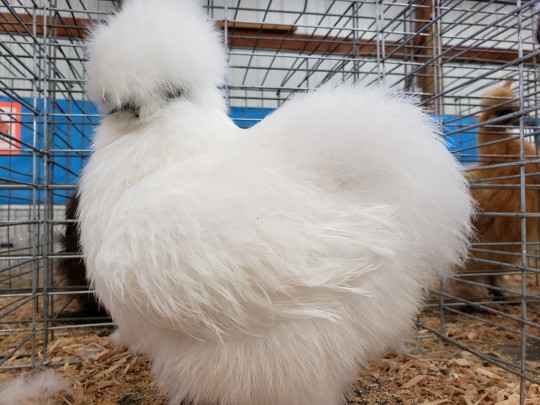
Hatcheries also pull skeevy moves like calling easter eggers (mutts that lay blue, green, pink, brown, or white eggs) "americanas" hoping that you mistake it for "ameraucana" the pure breed that lays stark blue eggs. Then they charge you ameraucana prices (like, $25/chick) when they should be charging more like $3-5 a chick. They'll do things like call a marans/barred rock mix a "mystic marans" as if it's a new color morph of a marans chicken instead of a mixed breed mutt they invented to be able to sex their chicks at hatch easier. People get these guys expecting MARANS eggs, and they get tan barred rock eggs. Same can go for temperament and behaviors. You go anywhere that has a group of chicken owners and ask them what their favorite breed is, you will get a range of answers with reasons like "my X is so sweet" while the next person will go "mine's the devil" and if you ask, 9 times out of 10, it's hatchery stock birds. Well bred private breeders often have MUCH more stable temperaments.
vs hatchery stock
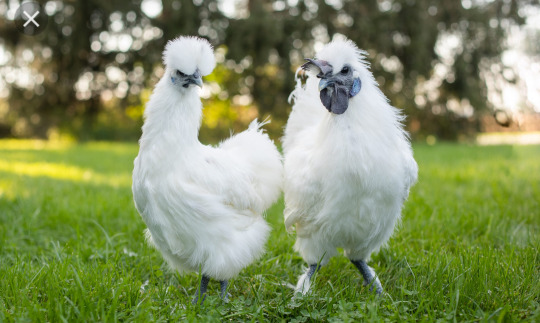
Getting from a private breeder also lets you get eggs, which can help you dodge a LOT of disease bullets. There's very little that transfers through the egg, strangely, and some of that is transferred on the surface of the eggs (like mycoplasma) so a quick santizing dip before incubation gets rid of that. I know that hatching them yourself is more of a hassle, but so is losing your flock to newcomers that came in with something entirely avoidable if you'd hatched instead. If your breeder is NPIP certified, they're getting tested for the major egg-traveling problem (pullorum) and a dip will take care of most anything else unless you're super SUPER unlucky.
Lastly on acquisitions, be prepared to get roosters. If you can't have roosters, be prepared to get them processed for yourself for food, or let the roosters go to food homes. Please please please please. There are so many, many excess roosters. They cannot all go to homes. The rooster to hen ratio in a flock is like 1:9. The rooster to hen ratio in hatching is nearly 1:1. Let someone make use of them. EVEN if you order from a hatchery, and order all pullets, they can make mistakes and send rooster babies. It's not a guarantee! Have a plan in advance! Mentally prepare yourself! Don't be one of Those People making posts in local groups about how you don't want/can't have this rooster but also no one else can eat it either. Chickens are a lot of things. Sometimes food is one of those things.
BEFORE actually acquiring the chickens, locate a vet that will see them. You are GOING to have an issue at some point in their lives, and that's not the time to start looking for a vet, that's the time to already have a vet on hand. In fact if you can support a yearly wellness check on at least one of the birds to test for communicable illnesses (like mycoplasma) and have a good relationship with your vet in advance, that's even better.
As for care, if you plan to contain the chickens, the minimum recommendation for a backyard coop and run varies wildly. For stress purposes, most chickens will find 4 feet of floor space per bird inside the coop adequate, accompanied by 10 square feet of space in a run per bird. Unlike peafowl, it doesn't matter how big the run is, the chickens will be turning the entire thing to bare soil, which is one of the reasons most people don't keep both in the same pens. I literally attempted to keep 2 standard chickens in a 1200 foot pen and they systematically went about destroying everything they could get to.
Most layer feeds are 16% protein; most layer feeds are also /production/ layer feeds, meant to feed production breeds in a space where they get NO other feed except this. If you plan to feed anything other than layer feed to them, like treats or whole foods or scratch grains, then you need to find a higher protein feed for them, because most treats are lower protein than layer feed. Avoid anything produced by Purina or Dumor (which is purina but TSC brand), except MAYBE the organic dumor 5-grain scratch grain, it's well-known as one of the worst quality fowl feeds out there. Check out your local mill and see if they have any options that are better than the big box farm stores. Kalmbach makes good feeds, as does Belstra.
Possibly counterintuitive, but stick with a smaller waterer over a larger waterer. You can keep a larger one around for if you go away for the weekend or something to make it easier on a sitter, but a smaller waterer like a 5-quart or gallon waterer will be easier to clean and make sure that you're giving fresh water more often, plus avoiding mosquitoes growing in it. Waterers can slime up really easily in the summer, so just be prepared to give it a quick swish clean every time you change the water out. Smaller waterers also make it easier to give them medication if you have something that goes in the water, especially since a lot of the water medications are "make fresh daily." Personally I don't bother with heated water bases anymore in the winter, I just have enough waterers to exchange them for a fresh one a couple times daily, while the old one thaws inside the back door on some plastic. The galvanized ones you have to use with the heated bases always got gross fast, with rust and discoloration and the stopper in the bottom always dried out and eventually cracked over the summer when we weren't using them.
Try to avoid straw bedding unless you REALLY trust the source. Straw is mostly for livestock, not poultry. It cannot catch the droppings of poultry the way shavings or sand or other beddings do, meaning the wet gunk drops to the floor under it and/or collects into grossness. It also molds easily, can carry in field parasites (since it's not treated the way shavings are often kiln fired before packaging), and breaks down into shards. I'm not saying you can't ever use it for any reason (I use it in some fashion, and have for over a decade, but not exclusively, and I trust my source, we've never gotten mites or anything, and I'm very careful about which bales I pick out), but if you have a choice, go for the wood substrates, or even for sand. A lot of people put sand in their runs because they can then rake it like kitty litter.
Look into what plants chickens can't have, and check your yard over thoroughly for them before adding chickens. Things like lilac bushes are toxic to them. Tomato and potato plants are nightshades so while they can have the fruits, the leaves and stems can be toxic. Stuff like that.
Lastly.... if anyone ever makes a claim about what something does for a chicken (example: diatomaceous earth, apple cider vinegar, pumpkin seeds, oregano, red pepper flakes, lavender, etc are all things I've seen people claim do all sorts of things from worming birds to curing respiratory infections), ask them for their source. If it's a blog post, ask them for a scientific article. If they can't provide it and you can't find one that backs up what they're saying, maybe reconsider the value of that particular advice. The thing is, the BIG production companies are VERY invested in finding cheap or organic or tricky ways to do WHATEVER it is (treat endo/ectoparasites, treat illness, make bigger or more eggs, change egg yolk color, etc), and they pour money into trying to figure out which old wives tales actually work and which ones don't. And if they haven't been able to prove it to a point where they'll spend money on it as a solution, then chances are REALLY GOOD that it's not a solution at all actually.
Things like how to clean coops, what feeds to get, what items to use for care, where to source birds, behavioral information etc, that's all stuff you can ask advice on in general public spaces. You'll still get a range of answers, and some of them will be garbage answers, but hardly any of them will do harm to your animals to do or not do. Like, for example, you can use a big waterer or a small waterer, as long as it's clean. You can vary coop and run size and still be fine. You don't have to feed exactly what someone else is feeding for your birds to be fine. You're probably going to try a few breeds before you find the one(s) you like best.
But when it comes to medical info or any kind of "treatment" type stuff? Consult a vet and/or at least look for scientific papers.
And lastly.... chicken math is Real, yo. However many chickens you think you want to get, plan on having the space for double that amount so you don't gotta rebuild anything when you ultimately decide wait, you need a couple more. The bigger space won't hurt them if you don't get more, but it'll be so much easier on you if you do ;)
227 notes
·
View notes
Note
Hello! I was wondering if u wouldn’t mind sharing a tutorial on how u making ur gif boarders? post/714133310754979840
hiii, yeah of course!

there are multiple ways to do it i'm sure, i'll share the two methods that i use the most. first tho, you need to create your selection for that border. (rest of tutorial under the cut, i use photoshop cs5 for reference)
in that example gif, the border is 10px away from all sides, and my gif dimension is 540px wide (width) and 440px tall (height). if i want a border that's 10px away from all edges, i need to remove that number from the dimension numbers.
540 - (10 + 10) = 520px for the width
440 - (10 + 10) = 420px form the height.
once you have your numbers for your gif, select the rectangular marquee tool. under style choose "fixed size" and enter the width and height in pixels (don't forget to add the letters "px" if they're not there).

once you have the numbers, click wherever in the canvas. this will create a selection with the right dimension. you can then move the selection around (with the mouse or arrow keys) until it's centered.
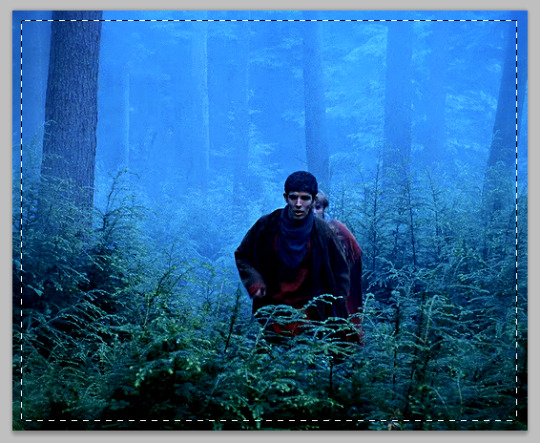
you can definitely draw the shape by hand without bothering with numbers if you want, but i like knowing that the border is the same ratio as the gif.
(if your gif is quared, you don't have to bother with numbers, you can just select "fixed ratio" in the style and enter 1 in both width and height, for a perfect square ratio. and then you can draw a box with the marquee tool until you reach the desired size.)
FIRST METHOD: LAYER STROKE
with that selection still on, create a new empty layer. this is where the stroke will go.

then go to the top menu: Edit > Stroke...
a stroke settings window will pop out, where you can choose the thickness in pixels, as well as the color and blending mode (i usually leave it at normal and edit the layer's blending mode if i want, instead). you can't edit these settings later, so be sure of what you want (which is why i usually prefer the second way).
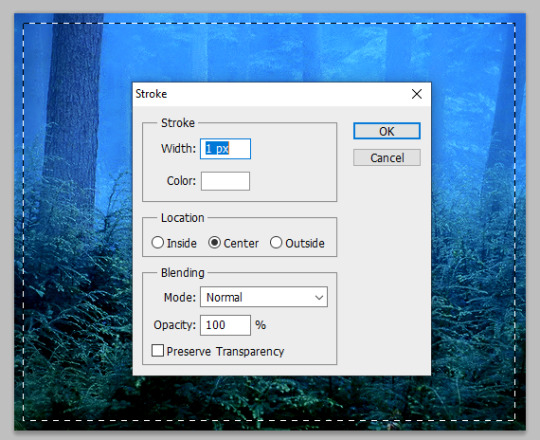
this is what a white 1px stroke border looks like:

SECOND METHOD: LAYER STYLES
i prefer this way, because you can later edit the color and thickness of the border if you want.
so, still with that selection activated from earlier, go to Layer > New Fill Layer > Color Fill. pick whatever color, this doesn't matter at all, we won't actually use that color fill. put the Fill of that new color fill layer at 0% opacity.

now that this layer is basically transparent at the moment, double click on it to enter the layer style options.
click on the Stroke option at the bottom and enter your desired values for size and color. you can change this later if you wish.
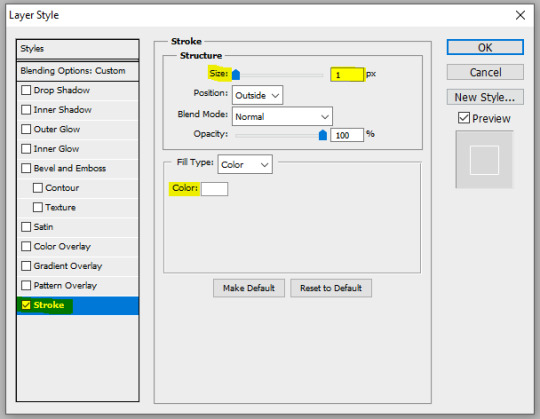
and this is what a white 1px stroke looks like with this method (looks basically the same yeah lol, but this method gives more flexibility)

CENTERING THE BORDER + FINAL TOUCHES
to make the border more interesting than just a white 1px stroke, you can change the layer's blending mode, as well as giving it more styles, such as: outer glow, inner glow, gradient overlay, color overlay. and don't hesitate to play with the blending modes for each of these layer styles too!
here's an example of settings with outer glow, inner glow, and a gradient 2px stroke:




to make sure the border is centered, here's a quick tip: select the stroke layer and the move tool. then with the keyboard, do Ctrl + A, it will make a selection of the canvas. then, click on these symbols at the top. it will center your layer horizontally and vertically.

and that's it :)
#alie replies#Anonymous#*ps help#tutorial#photoshop#resource#allresources#completeresources#usersmia#userabs#usercats#resources#resourcemarket
158 notes
·
View notes
Note
What snake has the highest width-to-length ratio? I know Gaboon vipers can be short & fat, wondering if there are any other species with that shape.
Gaboon vipers and other snakes in their genus (Bitis) are probably winners in that regard! But they're not unique by any means.
Gaboon vipers are very well known for being super heavy bodied snakes...

And other snakes in the Bitis genus, such as their cousin the beautiful rhinoceros viper, have similar body plans!
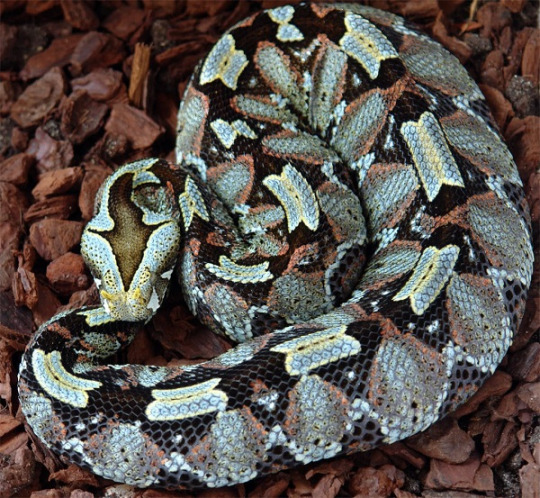
Vipers in general tend to be heavy-bodied snakes. Check out this cottonmouth - not as extreme as Bitis snakes, but still!

But it's not unique to vipers by any means! The Australian death adders (Acanthophis sp.), for example, fill a similar niche and look quite similar, despite being an elapid!
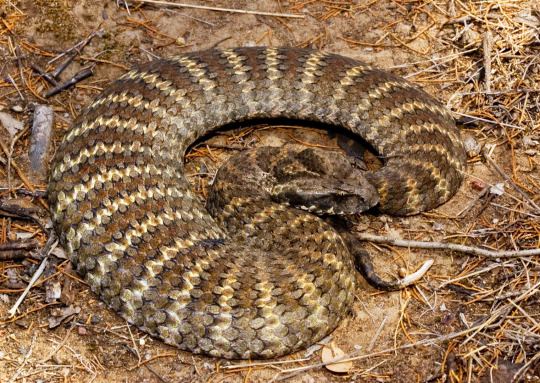
And we can't forget about some of my favorite snakes, the short-tailed pythons!

This body plan keeps popping up in the snake world because it's a great shape for highly specialized ambush predators. Most snakes are ambush predators, of course, but these snakes are specialized to hold very still and wait for a very long time. Aside from their body shape, this means they all also have lightning-quick strikes!
265 notes
·
View notes
Text
I just wanna say something real quick.
I love all of you so much, and don't get me wrong, I love seeing you guys read my work.
Please don't take this the wrong way.
Why don't you guys reblog? I'm just looking at the like to reblog ratio on my most recent fics and drabbles and it's honestly so disappointing. And it's not just on my fics, I've noticed it on my friends fics too.
Here are two examples:


And yeah, those reblog numbers aren't the lowest but you've gotta keep in mind that a lot of those are me responding to comments or doing timezone reblogs to make sure my friends are seeing it in the first place. So, half those numbers at least is how many people are sharing my work with their friends. Half.
Tumblr doesn't work like twitter or tiktok or any of the other social media platforms where likes get your work circling the community. On tumblr, only reblogs do that.
And why wouldn't you want to share something you enjoyed? Because you'll be embarrassed? Because people might think "oh this person's weird" and unfollow you? If that's what they think of you, then they weren't worth keeping on your page in the first place.
Surround yourself with people and blogs who're into the same things you are. Who's gonna see you share a fic and go "ooo lemme read it too."
Reblogging is how you support authors on this hellsite, and I don't think we're asking for much when we ask you to share our work. You don't even have to put anything in the tags or write a comment if you don't want to - it's okay. Seeing you share it is more than enough. (Though we do love seeing your reactions)
Please. Support your authors. Show them some love. Share their work.
#this has been a psa#I’m not trying to pick a fight#or call anyone out#i’m just confused#and curious#support your writers
397 notes
·
View notes
Text
How to Kink Meme 101
I think that for fans who never used Dreamwidth and didn't grow up on LiveJournal, kink memes can be a little intimidating (I know I was intimidated initially). But I've also never seen a format that works better for hosting one that Dreamwidth. So here is a quick guide to get you reading and posting on kink memes (and YES, there ARE still active kink memes on DW--and if your fandom's isn't, make a new one!)
And just to cover upfront: Despite the name, requests and fills generally do not have to be sexual in nature (a kink meme will state in the rules if requests are required to be sexual). You can usually request anything on the kink meme, from the smuttiest smut to the fluffiest fluff and everything in between.
The first step is always to review that kink meme's rules. Most of them will be common sense--don't bash, don't out another poster, stay on topic, etc. But it's always good to check in case there's something you didn't expect (ex: some kink memes require you to put certain trigger warnings in the title of a request).
TO REQUEST:
Find the active prompt post. Many kink memes for larger fandoms will have multiple prompt posts. When one gets too long, mods will close it to new requests and start a new one. They will usually try to make it very clear which is the active one. Here's an example from the Dragon Age kink meme:

Part 8 is where you go to prompt. Other parts may still be open for fills, but are closed for new prompts. Here's another example from the Mass Effect kink meme:

Here, the current post is stickied to the top of the page, and is tagged "current part" to let you know it's the active prompt post.
2. Once you select the right prompt post, make sure you're replying to the prompt post itself, not to someone else's comment. DW pages vary in style, but that reply button can reliably be found at the bottom of the page. Here's another example from the DAO page:

The "reply" option WITHIN that bottom request will respond directly to that comment. The "reply" option in the bar at the bottom will reply to the entire thread. That's the one you want to hit.
Here's another example from The Silmarillion kink meme:

And one more from Middle-earth kink:
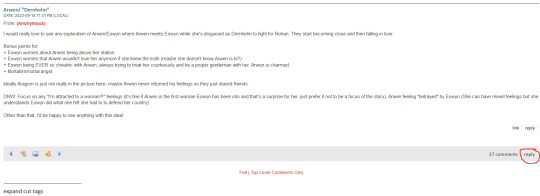
3. Okay so you've hit reply and you're ready to type out your idea. The one most important requirement of all kink memes is anonymity. Anonymity in requests, and in posting. Even if you feel comfortable posting with your username attached, you need to post anonymously. You can de-anon somewhere else and even link to that, but the post on the kink meme should be anonymous. That's where this button comes in:
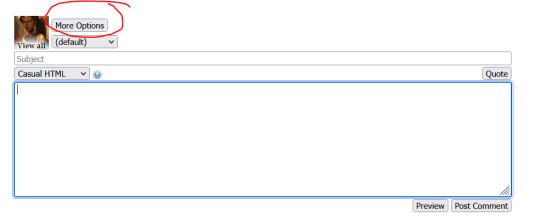
"More options." You hit that, and you'll get the option to make an anonymous post:

And now you're really ready to go. Put something short and descriptive in the title (Ex: "Kirk/Spock Coffee Shop AU" or "Iron Bull get pegged") and give a longer description (as needed) in the body. Requests can be as short as a sentence or as long as several paragraphs--whatever you feel like is necessary.
Make sure to include any "do not wants" here! If you aren't sure what that means, check below.
NB: Generally, it's considered polite to keep a reasonable ratio of requests::fills. That is, if you're making a lot of requests, you should be trying to fill some from others. It doesn't have to be only fic either--if you're better at drawing than writing, a fanart fill most often works too!
TO FILL:
Okay, so there's requests...but say you find an idea you really like and you want to give OP a fill. It's going to be the same deal as before, except in the body of your post you'll put the fic rather than a request. DW has a character limit per comment, so it's not unusual to break even a relatively short fill into multiple posts. Nor do you have to post the whole fill at once--updating as you do with a fic elsewhere is totally fine. Here's what it will look like when multiple fill posts nest:

And that's really all there is to the basics! DW is an older, more barebones site, so if you're accustomed to the newer web, it may seem clunky and hard to navigate, but once you've posted a time or two it will seem very simple and the kink meme community is a lot of fun!
ADDITIONAL NOTES:
"Do not derail" - Generally it's common courtesy on the kink meme not to derail a request. That is, if someone wants "A/B outdoor temple sex" it's considered rude to comment "Would love to see this with A/C!" If you like the idea but want something changed, it's better to just post your own request, even if it's very similar.
Asking for clarification - It's totally fine if you want to ask OP for clarification on a point before making a fill. Keeping it anonymous, you can just respond to the original prompt to see if they meant X or Y, or if they would be okay with Z thing in the fic.
"Bonus" requests - It's pretty common to see "bonus" requests in a prompt. That is, things OP would like to see, but are fine not receiving. You can put as many of these as you like in your requests, and as a filler, can choose to include or not include as many of them as you want. Here's what that might look like:


5. DNW - "Do not wants." This is where you put anything that would be a deal-breaker for you: something that would cause you to not read the fic at all, or not to enjoy it. Again, you can put as many as you want, or none. Here are some examples of that:
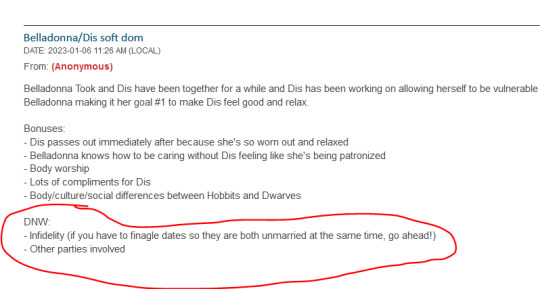
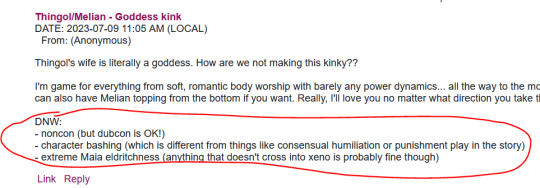
6. Commenting!! - If someone fills your prompt, you should make sure to thank them! Even if the fill wasn't exactly what you wanted, it's nice to find something kind to say about it, since someone spent the time to write something for you. And of course, feel free to comment even if the prompt wasn't yours!
7. Multiple fills - There is absolutely no problem with doing multiple fills on a prompt! If the prompt inspires you, go for it! I've definitely written fills for prompts that already had two or three fills. Usually, OP is delighted to have more than one fill ^.^ I think it's really interesting to see where different authors take the same prompt, and some prompts are open to a variety of characters.
8. Fill posts - Some kink memes also have a separate "fill post," somewhere you drop links to fills. This is just a neat way of collecting them, so if you fill a prompt, try to drop a link there, just to get more eyes on it!
9. De-anoning - So you've written a fill anonymously, but you want to share on your AO3/tumblr/Twitter/wtv. Feel free! You can out yourself as the author of a fill wherever else you want, and "de-anon from the kink meme" was a pretty common author's note to see back in the day. You can even comment on the original kink meme fill with a link to other places you've posted it. Personally, I usually come back and drop an AO3 link to any fills I crosspost.
10. Timing - Some kink memes are quite old, with requests going back 10+ years. The OP of that prompt may no longer be checking it, but that shouldn't stop you from filling the prompt if you like it--you're almost sure to find another audience owo
11. Alerts - DW is pretty limited in the "notifications" you can receive from it, but if you have or make a DW account and want to get notified of updates on a kink meme, you'll want to first subscribe to that page.
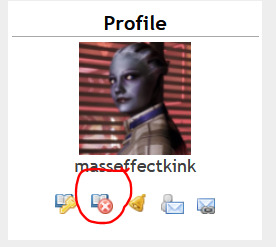
(I'm already subscribed here, but that little journal will show a green checkmark if you aren't yet subscribed, and you just hit that so that any new posts on the meme will go into your DW feed.)
However, because kink memes operate more on comments than posts, you'll also want to get alerts for any new comments from the active prompt post. Find the active prompt post, and hit this bell button:

You'll get this pop-up:

And you can go ahead with the email notif, or if you're like me and want DW notifications to stay on DW and out of my email, hit "More Options" and uncheck the email notif. This way, any new comments will only show up in your DW inbox as an unread message.

And that's everything! Or at least everything I can think of. If you have another question please feel free to comment. I think kink memes are a lot of fun and I hate to think of anyone unable to participate because they're not familiar with the format.
Enjoy!
Kink memes in this post (+ some others):
Dragon Age main page (Origins, II, Inquisition)
Middle-earth kink
Silm kink meme
Arcane kink meme
Mass Effect kink
Skyrim kink meme
90 notes
·
View notes
Note
Hello hello! May I please ask for 🧠 for cassian? It would complete the bat boy set 😁
Hi love! Absolutely!! Thank you for the ask <3!!!
Okay let's start with SFW headcanon's and work our way from there!
Cassian is known to be very tall and just very strong in general. This male is picking you up all the time, hugging you close to his chest, throwing you over his shoulder, holding you by your armpits sometimes. He just loves being able to show off his strength by picking you up like a little rag-doll.
He is so freaking supportive of everything that you pursue. For example, in terms of training, it was not something you were initially interested in. He would wake up early in the morning and give you a soft forehead kiss, mumbling a little goodbye and be back soon, before going up to train. One day, you decided to join him just to see what he was like during training. First off...
This male was incredibly attractive, like had you blushing, feeling warm alllll over, even though it was almost freezing outside. Shirtless Cassian is the best Cass in your humble opinion. But to see him being so strong, so direct, so attentive, caring, but also acting like a true leader had you on your knees.
You basically decided to join training that day just to have the male gentely correct your form, encourage you by pressing quick kisses all over your face, sometimes smacking your ass before sending you off to do lunges with the other valkaryies.
Another example, this male was so supportive when you decided your career path. It took a long time for you to decide weather you wanted to do something in the inner circle or just have a normal every day job like working at a bookstore or cafe. At the end of the day, he always allowed you to explore your options and was always so excited to hear about how your day went, how you felt about your work, any gossip you had overheard... And when you decided what you wanted to do, he was the first to congratulate you and just be so happy for you.
Cass and you are busy fucking bodies. Y'all know the ins and outs of everyone you know. And it is so much fun to lay in bed before falling asleep or just at the crack of dawn when Valeris is asleep and only you two are awake to just discuss everything, give your opinions and theories, giggling and cuddling close.
I know that everyone thinks Cass is a brute, but he truly is this gentle giant who is actually extremely intelligent. He has deep conversations with you that range from history, to emotions, to odds and ratios of winning battles, to battle strategies, to the economic state of other courts. He will pick you up, and hold you close, rocking you as he discusses with you all the different questions that you can think of.
He loves loves loves stroking your hair. And even more-so, he loves when you play with his hair. He is practically falling on top of you when he comes home from training or a day out in Windhaven or other illyrian war camps. And you rest his head against your chest, braiding his hair, allowing for your heartbeat to lull him into sleep.
Okay some NSFW headcanons so skip/DNI if minor, 18+ only
Cassian loves to smack your ass/play with your ass. He just loves how it fits into his hands, and he loves the way it jiggles. Any time your ass is somewhat stuck up in the air, you can almost gauruntee this male will find his hand squeezing it, pinching it, smacking it.
And he uses such force with his spanks... this one time, you were leaning down to pick up Cassian's sweater off the floor, from where you had thrown it last night after pratically ripping it off of him, and this male spanked you so hard, you nearly went flying into the bedpost
speaking of bedposts.... this male has tied you down and had his way with you. Literally six orgasms on his tongue later, and he was still not finished with you. He proceeded to fuck you on his cock for several more orgasms.
Loves leaving hickeys all over your chest, your neck, basically anywhere that is exposed, you will find a hickey. At first you complained, and poor male tried stopping, but he just cannot get enough of you. Eventually you kinda just gave in and now where his hickeys with pride.
Blowjobs galore. This male loves to sit back and watch your head bob up and down on his cock. And you can't even fit his size in... you have to use your hands to help stimulate every portion. But gods does he love when you get on your fucking knees for him. And then he will cum on your chest, marking you as his own....
This male has a fucking size kink. It is practically canon this male is the largest out of the bat boys, and he towers, and I mean towers over you. Like you need to turn your head up just to look at him, and any time you do, this male gets a smug smirk on his face and just throws you over his shoulder so he can toss you onto the bed and fuck you into oblivion.
TBH the first time you saw his cock, you were not sure it was gonna fit and you know what he said to you???
"I'll make it fit." and "Your cunt is so perfect and tight, sucking me in like it was meant to be sweetheart." and "So fucking tight sweets." and "You're gonna be so sore in the morning, and who did that to you?"
Also... he has a possessive kink and a breeding kink...
"Who do you belong to slut?" and "Gonna pump your cunt full of my cum sweetheart" and "Gonna look so fucking pretty swollen with my babe" and "Who owns this cunt?"
Instant orgasm
And he keeps fucking you through it
If your mix of cum ever leaks out... he is fingering it back in despite your shaking legs and spasming body, "Keep it inside sweets"
He loveesss overstimulating you... you are constantly made fun of by the inner circle for walking funny every time you manage to get out of bed in the morning. And Cass just smirks staring down at you as you blush.
I just... he is so fucking hot... sigh...
395 notes
·
View notes
Text
Music theory notes (for science bitches) - part 2: pentatonics and friends
or, the West ain't all that.
Hello again everyone! I'm grateful for the warm reception to the first music theory notes post (aka 'what is music? from first principles'). If you haven't read it, take a look~
In that stab at a first step towards 'what is music', I tried to distinguish between what's a relatively universal mathematical structure (nearly all musical systems have the octave) and what's an arbitrary convention. But in the end I did consciously limit myself, and make a beeline for the widely used 12TET tuning system and the diatonic scales used in Western music. I wanted to avoid overwhelming myself, and... 👻 it's all around us...👻
But! But but but. This is a series on music theory. Not just one music theory. The whole damn thing. I think I'm doing a huge disservice to everyone, not least me, if that's where we stop.
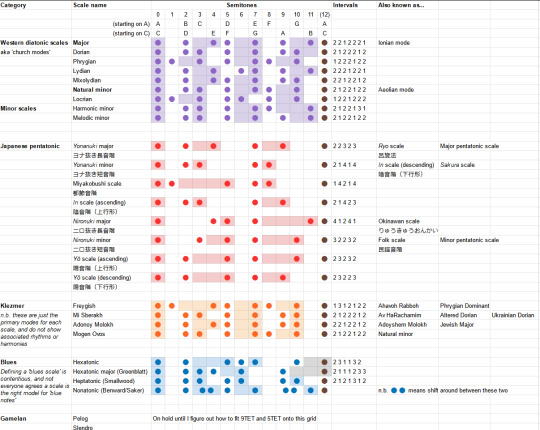
Today, then! For our second installation: 'Music theory notes (for science bitches)' will take a quick look through some examples that diverge from the diatonic scale: the erhu, Japanese pentatonic scales, gamelan, klezmer, and blues.
Also since the first part was quite abstract, we'll also having a go at using the tools we've built so far on a specific piece, the Edo-period folk song Sakura, Sakura.
Sound fun? Let's fucking gooooo
The story so far
To recap: in the first post we started by saying we're gonna be looking at tonal music, which isn't the only type of music. We introduced the idea of notes and frequencies by invoking the magic name of Fourier.
We said music can be approximated (for now) as an idealised pressure wave, which we can divide into brief windows called 'notes', and these notes are usually made of a strong sine wave at the 'fundamental frequency', plus a stack of further sine waves at integer multiples of that frequency called 'overtones'.
Then, we started constructing a culturally specific but extremely widespread system of creating structure between notes, known as '12 Tone Equal Temperament' or 12TET. The main character of this story is the interval, which is the ratio between the fundamental frequencies of two notes; we talked about how small-integer ratios of frequencies tend to be especially 'consonant' or nice-sounding.
We introduced the idea of the 'octave', which is when two notes have a frequency ratio of 2. We established the convention treating notes an octave apart as deeply related, to the point that we give them the same name. We also brought in the 'fifth', the ratio of 1.5, and talked about the idea of constructing a scale using small-integer ratios.
But we argued that if you try and build everything with those small-integer ratios you can dig yourself into a hole where moving around the musical space is rife with complications.
As a solution to this, I pulled out 'equal temperament' as an approximation with a lot of mathematical simplicity. Using a special irrational ratio called the "semitone" as a building block, we could construct the Western system of scales and modes and chords and such, where
a 'scale' is kind of like a palette for a piece of music, defined by a set of frequency ratios relative to a 'root' or 'tonic' note. this can be abstract, as in 'the major scale', or concrete, as in 'C major'.
a 'mode' is a cyclic permutation of an abstract scale. although it may contain the same notes, moving them around can change the feeling a lot!
a 'chord' is playing multiple notes at the same time. 'Triad' chords can be constructed from scales. There are other types which add or remove stuff from the triads. We'll come back to this.
I also summarised how sheet music works and the rather arbitrary choices in its construction, and at the end, I very briefly talked about chord notation.
There's a lot of ways to do this...
I recently watched a video by jazz musician and music theory youtuber Adam Neely, in which he and Philip Ewell discuss how much "music theory" is treated as synonymous with a very specific music theory which Neely glosses as "the harmonic style of 18th-century European composers". He argues, pretty convincingly imo, that 'music theory' pedagogy is seriously weakened by not taking non-white/Western models, such as Indian classical music theories, as a foil - citing Anuja Kamat's channel on Indian classical music as a great example of how to do things differently. Here's her introductory playlist on Indian classical music concepts, which I will hopefully be able to lean on in future posts:
There's two big pitfalls I wanna avoid as I teach myself music theory. I like maths a lot, and if I can fit something into a mathematical structure it's much easier for me to remember it - but I gotta be really careful not to mathwash some very arbitrary conventions and present them as more universal than they are. Music involves a lot of mathematics, but you can't reduce it to maths. It's a language for expressing emotion, not a predicate to prove.
One of the big goals of this series is to get straight in my head what has a good answer to 'why this way?', and what is just 'idk it's the convention we use'. And if something is an arbitrary convention, we gotta ask, what other conventions exist? Humans are inventive little buggers after all.
I also don't want to limit my analytical toolbox to a single 'hammer' of Western music theory, and try and force everything else into that frame. The reasons I'm learning music theory are... 1. to make my playing and singing better, and be more comfortable improvising; 2. to learn to compose stuff, which is currently a great mystery. How do they do it? I do like Western classical music, but honestly? Most of the music I enjoy is actually not Western. I want to be able to approach that music on its own terms.
For example, the erhu... for erhuample???
The instrument family I'm learning, erhu/zhonghu, is remarkably versatile - there are no frets (or even a soundboard!) to guide you, which is both a challenge and a huge freedom. You can absolutely play 12TET music on it, and it has a very beautiful sound - here is an erhu harmonising with a 12TET-tuned piano to play a song from the Princess Mononoke soundtrack, originally composed by Joe Hisaishi as an orchestral piece for the usual Western instruments...
youtube
This performance already makes heavy use of a technique called (in English) 'vibrato', where you oscillate the pitch around as you play the note (which means the whole construction that 'a note has a fixed pitch defined by a ratio' is actually an abstraction - now a note's 'frequency' represents the middle point a small range of pitches!). Vibrato is very common in Western music too, though the way you do it on an erhu and the way you do it on a violin or flute are of course a little different. (We could do an aside on Fourier analysis of vibrato here but I think that's another day's subject).
But if you listen to Chinese compositions specifically for Erhu, they take advantage of the lack of fixed pitch to zip up and down like crazy. Take the popular song Horse Racing for example, composed in the 1960s, which seems to be the closest thing to the 'iconic' erhu piece...
youtube
This can be notated in 12TET sheet music. But it's also taking full advantage of some of the unique qualities of the erhu's long string and lack of frets, like its ability to glide up and down notes, playing the full range of 'in between' frequencies on one string. The sheet music I linked there also has a notation style called 简谱 jiǎnpǔ which assigns numbers to notes. It's not so very different from Western sheet music, since it's still based on the diatonic major scale, but it's adjusted relative to the scale you're currently playing instead of always using C major. Erhu music very often includes very fast trills and a really skilled erhu/zhonghu player can jump between octaves with a level of confidence I find hard to comprehend.
I could spend this whole post putting erhu videos but let me just put one of the zhonghu specifically, which is a slightly deeper instrument; in Western terms the zhonghu (tuned to G and D) is the viola to the erhu's violin (tuned to D and A)...
youtube
To a certain degree, Chinese music is relatively easy to map across to the Western 12-tone chromatic scale. For example, the 十二律 shí'èr lǜ system uses essentially the same frequency ratios as the Pythagorean system. However, Chinese music generally makes much heavier use of pentatonic scales than Western music, and does not by default use equal temperament, instead using its own system of rational frequency ratios. correction: with the advent of Chinese orchestras in the mid-20thC, it seems that Chinese instruments now usually are tuned in equal temperament.
I would like my understanding of music theory to have a 'first class' understanding of Chinese compositions like Horse Racing (and also to have a larger reference pool lmao). I'm going to be starting formal erhu lessons next month, with a curriculum mostly focused on Chinese music. If I have interesting things to report back I'll be sure to share them!
Anyway, in a similar spirit, this post we're gonna try and do a brief survey of various musical constructs relevant to e.g. Japanese music, Klezmer, Blues, Indian classical music... I have to emphasise I am not an expert in any of these systems, so I can't promise to have the most elegant form of presentation for them, just the handles I've been able to get. I will be using Western music theory terms quite a bit still, to try and draw out the parallels and connections. But I hope it's going to be interesting all the same.
Let's start with... pentatonic scales!
Pentatonic scales
In the previous post we focused most of our attention on the diatonic scale. Confusingly, a "diatonic" scale is actually a type of heptatonic scale, meaning there are 7 notes inside an octave. As we've seen, the diatonic scale is constructed on top of the 12-semitone system.
Strictly defined, a 'diatonic' scale has five intervals of two semitones and two intervals of one semitone, and the one-semitone intervals are spread out as much as possible. So 'diatonic scales' includes the major scale and all its cyclic permutations (aka 'modes'), including the natural minor scale, but not the other two minor scales we talked about last time!
However, whoever said we should pick exactly 7 notes in the octave? That's rather arbitrary, isn't it?
After all, in illustration, a more restricted palette can often lead to a much more visually striking image. The same is perhaps even more true in music!
A pentatonic scale is, as the name suggests, a scale which has five notes in an octave. Due to all that stuff we discussed with small-number ratios, the pentatonic scales we are about to discuss can generally be mapped quite easily onto the 12-tone system. There's some reason for this - 12TET is designed to closely approximate the appealing small-number frequency ratios, so if another system uses the same frequency ratios, we can probably find a subset of 12TET that's a good match.
Of course, fitting 12TET doesn't mean it matches the diatonic scale, necessarily. Still, once you're on the 12 tone system, there's enough diatonic scales out there that you can often define a pentatonic scale in terms of a delta relative to one of the diatonic scale modes. Like, 'shift this degree down, delete that degree'.
Final caveat: I'm not sure if it's strictly correct to use equal temperament in all these examples, but all the sources I find define these scales using Western music notation, so we'll have to go with that.
Sakura, sakura and the yonanuki scale
Let's start with Japanese music. Here's the Edo-period folk song Sakura, Sakura, which is one of the most iconic pieces of Japanese music¸ especially abroad:
youtube
This uses the in scale, also known as the sakura pentatonic scale, one of a few widely used pentatonic scales in Japanese folk music, along with the yo scale, insen scale and iwato scale... according to English-language sources.
Finding the actual Japanese was a bit difficult - so far as I can tell the Japanese wiki page for Sakura, Sakura never mentions the scale named after it! - but eventually I found a page for pentatonic scales, or 五音音階 goon onkai. So we can finally determine the kanji for this scale is 陰音階 in onkai or 陰旋法 in senpou. [Amusingly, the JP wiki article on pentatonic scales actually leads with... Scottish folk songs and gamelan before it goes into Japanese music.]
However, perhaps more pertinent is this page: ヨナ抜き音階 which introduces the terms yonanuki onkai and ニロ抜き音階 nironuki onkai. This can be glossed as 'leave out the fourth (yo) and seventh (na) scale' and 'leave out the second (ni) and sixth (ro) scale', describing two procedures to construct pentatonic scales from a diatonic scale.
Let's recap major and minor. Last time we defined them using semitone intervals from a root note (the one in brackets is the next octave):
position: 1, 2, 3, 4, 5, 6, 7, (8)
major: 0, 2, 4, 5, 7, 9, 11, (12)
minor: 0, 2, 3, 5, 7, 8, 10, (12)
From here we can construct some pentatonic scales. Firstly, here are your yonanuki scales - the ones that delete the fourth and seventh:
major: 0, 2, 4, 7, 9, (12)
minor: 0, 2, 3, 7, 8, (12)
Starting on C for the major and A for the minor (the ones with the blank key signature), this is how you notate that in Western sheet music. As you can see, we have just deleted a couple of steps.


The first one is the 'standard' major pentatonic scale in Western music theory; it's also called the ryo scale in traditional Japanese music (呂旋法 ryosenpou). The second one is a mode (cyclic permutation) of a scale called 都節音階 miyakobushi, which is apparently equivalent to the in scale.
In terms of gaps between successive notes, these go:
major: 2, 2, 3, 2, 3 - very even
minor: 2, 1, 4, 1, 4 - whoah, huge intervals!
The miyakobushi scale, for comparison, goes...
miyakobushi (absolute): 0, 1, 5, 7, 8, (12)
miyakobushi (deltas): 1, 4, 2, 1, 4
JP wikipedia lists two different versions of the 陰旋法 (in scale), for ascending and descending. Starting on C, one goes C, D, Eb, G, A; the other goes C, D, Eb, G, Ab. Let's convert that into my preferred semitone interval notation:
in scale (absolute, asc): 0, 2, 3, 7, 9, (12)
in scale (relative, asc): 2, 1, 4, 2, 3
in scale (absolute, desc): 0, 2, 3, 7, 8, (12)
in scale (relative, desc): 2, 1, 4, 1, 4
So we see that the 'descending form' of the in scale matches the minor yonanuki scale, and it's a mode (cyclic permutation) of the miyakobushi scale.
We've talked a great deal about the names and construction of the different type of scales, but beyond the vague gesture to the standard associations of 'major upbeat, minor sad/mysterious' I don't think we've really looked at how a scale actually affects a piece of music.
So let's have a look at the semitone intervals in Sakura, Sakura in absolute terms from to the first note...
sakura, sakura, ya yoi no so ra-a wa
0, 0, 2; 0, 0, 2; 0, 2, 3, 2, 0, 2-0, -4
and in relative terms between successive notes:
sa ku ra, sa ku ra, ya yo i no so ra-a wa
0, 0, +2; -2, 0, +2; -2, +2, +1, -1, -2, +2, -2, -4
If you listen to Sakura, Sakura, pay attention to the end of the first line - that wa suddenly drops down a huge distance (a major second - for some reason I miscalculated this and thought it was a tritone) and that's where it feels like damn, OK, this song is really cooking! It catches you by surprise. We can identify these intervals as belonging to the in/yoyanuki minor scale, and even starting on its root note.
Although its subject matter is actually pretty positive (hey, check it out guys, the cherry blossoms are falling!), Sakura, Sakura sounds mournful and mysterious. What makes it sound 'minor'? The first phrase doesn't actually tell you what key we're in, that jump of 2 semitones could happen in major or minor. But the second phrase, introduces the pattern of going up 2, then up 1, from the root note - that's the minor scale pattern. What takes it beyond just 'we're in minor'? That surprise tritone move down. According to the rough working model that 'dissonant notes create tension, consonant notes resolve it', this creates a ton of tension. This analysis is bunk, there isn't a tritone. It's a big jump but it's not that big a jump.
How does it eventually wrap up? The final phrase of Sakura, Sakura goes...
i za ya, i za ya, mi ni yu - u ka nn
0, 0, 2; 0, 0, 2; -5, -4, 2, 0, -4, -5
0, 0, +2; -2, 0, +2; -5, +1, +4, -2, -4, -1
Here's my attempt to try and do a very basic tonal/interval analysis. We start out this phrase with the same notes as the opening bars, but abruptly diverge in bar 3, slowing down at the same time, which provides a hint that things are about to come to a close. The move of -5 down is a perfect fourth; in contrast to the tritone major second we had before, this is considered a very consonant interval. (A perfect fourth down is also equivalent to going up a fifth and then down an octave. So we're 'ending on the fifth'.) We move up a little and down insteps of 4, 2, and 1, which are less dramatic. Then we come back down and end on the fifth. We still have those 4-steps next to 1 steps which is the big flag that says 'whoah we're in the sakura pentatonic scale', but we're bleeding off some of the tension here.
Linguistically, the song also ends on the mora ん, the only mora that is only a consonant (rather than a vowel or consonant-vowel), and that long drawn-out voiced consonant gives a feeling of gradually trailing away. So you could call it a very 'soft' ending.
Is this 'tension + resolution' model how a Japanese music theorist would analyse this song? It seems to be a reasonably effective model when applied to Japanese music by... various music theorist youtubers, but I don't really know! That's something I want to find out more about.
Something raised on the English wiki is the idea that the miyakobushi scale is divided into two groups, spanning a fourth each, which is apparently summarised by someone called Koizumi Fumio in a book written in 1974:

Each group goes up 1 (a semitone or minor second), then 4 (major third), for a total of 5 (perfect fourth). The edges of these little blocks are considered 'nucleus' notes, and they're of special importance.
Can we see this in action if we look at Sakura, Sakura? ...ehhhh. I admit, the way I think of the song is shaped by the way I play it on the zhonghu; I think of the first two two-bar phrases as the 'upper part' and the third phrase as the 'lower part', and neither lines up neatly with these little groups. Still. I suspect Koizumi Fumio, author of Nihon no ongaku, knows a little more about this than I do, so I figure it's worth a mention.
Aside: on absorbing a song
Sakura, Sakura is kinda special to me because it's like the second piece I learned to play on zhonghu (after Twinkle, Twinkle Little Star lmao). I can't play it well, but I am proud that I have learned to play it at least recognisably.
The process of learning to play it involved writing out tabs and trying out different ways of moving my hand. I transcribed Sakura Sakura down to start on F, since that way the open G string of the zhonghu could be the lowest note of the piece, and worked out a tab for it using a tab system I cooked up with my friend. Here's what it looks like. The system counts semitones up from the open string, and it uses an underline to mark the lower string.

(Also, credit where it's due - I would never have made any progress learning about music if not for my friend Maki Yamazaki, a prodigiously multitalented self-taught musician who can play dozens of instruments, and also the person who sold me her old zhonghu for dirt cheap, if you're wondering why a white British girl might be learning such an unusual instrument. You can and should check our her music here! Maki has done more than absolutely anyone to make music comprehensible to me, and a lot of this post is inspired by discussing the previous post with her.)
When you want to make a song playable on an instrument, you have to perform some interpretation. Which fingers should play which notes? When should you move your hand? How do you make sure you hit the right notes? At some point this kind of movement becomes second nature, but I'm at the stage, just like a player encountering a new genre of videogame, where I still don't have the muscle memory or habituation to how things work, and each of these little details has to be worked out one by one. But this is great, because this process makes me way more intimately familiar with the contours of the song. Trying to analyse the moves it makes like the above even more so.
More Japanese scales
So, to sum up what we've observed, the beautiful minor sounds of Sakura Sakura come from a pentatonic scale which can be constructed by taking the diatonic scale and blasting certain notes into the sea, namely the fourth and the seventh of the scale. But what about the nironuki scale? Well, this time we delete the second and the sixth. So we get, in absolute terms:
major nironuki (abs): 0, 4, 5, 7, 11, (12)
major nironuki (rel): 4, 1, 2, 4, 1
minor nironuki (abs): 0, 3, 5, 7, 10, (12)
minor nironuki (rel): 3, 2, 2, 3, 2
Hold on a minute, doesn't that look rather familiar? The major nironuki scale is a permutation, though not a cyclic permutation, of the minor yonanuki scale. And the minor nironuki scale is a cyclic permutation (mode) of the major one.
Nevertheless, these scales have names and significance of their own. The major one is known as the 琉球音階 ryūkyū onkai or Okinawan scale. The minor one is what Western music would call a 'minor pentatonic scale'. It also mentions a couple of other names for it, like the 民謡音階 minyou onkai (folk scale).
We also have the yō scale, which like the in scale, comes in ascending and descending forms. You want these too? Yeah? Ok, here we go.
yō scale (asc, abs): 0, 2, 5, 7, 10, (12)
yō scale (asc, rel): 2, 3, 2, 3, 2
yō scale (desc, abs): 0, 2, 5, 7, 9, (12)
yō scale (desc, rel): 2, 3, 2, 2, 3
The yō scale is what's called an anhemitonic pentatonic scale, which is just a fancy way of saying it doesn't have semitones. (The in scale in turn is hemitonic). The ascending form is also called the 律戦法 ritsusenpou. Here's the complete table of all the variants I've found so far.
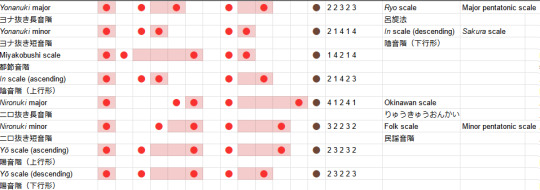
So, in summary: Japanese music uses a lot of pentatonic scales. (In a future post we can hopefully see how that applies in modern Japanese music). These pentatonic scales can be constructed by deleting two notes from the diatonic scales. In general, you land in one of two zones: the anhemitonic side, where all the intervals between successive notes, are 2 and 3, and the hemitonic side, where the intervals are spicier 1s and 4s and a lone 2. From there, you can move between other pentatonic scales by cyclic permutations and reversal.
If you analyse Japanese music from a Western lens, you might well end up interpreting it according to one of the modes of the major scale. In fact, the 8-bit music theory video I posted last time takes this approach. This isn't wrong per se, it's a viable way to getting insight into how the tune works if you want to ask the question 'how does this conjure emotions and how do I get the same effects', but it's worthwhile to know what analytical frame the composers are likely to be using.
Gamelan - when 12TET won't cut it
Gamelan is a form of Indonesian ensemble music. I do not at this time know a ton about it, but here's a performance:
youtube
However, if you're reading my blog then it's likely that if know gamelan from anywhere, it's most likely the soundtrack to Akira composed by Shōji Yamashiro.
youtube
This blends traditional gamelan instrumentation and voices with modern synths to create an incredibly bold and (for most viewers outside Indonesia!) unfamiliar sound to accompany the film's themes of psychic awakening and evolution. It was an inspired choice, adding a lot to an already great film.
'A gamelan' is the ensemble; 'gamelan' is also the style of music. There are many different types of gamelan associated with different occasions - some gamelans are only allowed to form for special ceremonies. Gamelan is also used as a soundtrack in accompaniment to other art forms, such as wayang kulit and wayang wong (respectively, shadow puppetry and dance).
Since gamelan music evidently uses quite a bit of percussion, and so far we've been focused on the type of music played on strings and wind instruments - a brief comment on the limitations of our abstractions. Many types of drums don't fit the 'tonal music' frame we've outlined so far, creating a broad frequency spectrum that's close to an enveloped burst of white noise rather than a sharply peaked fundamental + overtones. There's a ton to study in drumming, and if this series continues you bet I'll try to understand it.
But there are tonal percussion instruments, and a lot of them are to be found in gamelan, particularly in the metalophone family (e.g. the ugal or jegogan). The Western 'xylophone' and 'glockenspiel' also belong to this family. Besides metalophones, you've got bells, steel drums, tuning forks etc. Tuning a percussion instrument is a matter of adjusting the shape of the metal to adjust the resonant frequency of its normal modes. I imagine it's really fiddly.
In any case, the profile of a percussion note is quite different from the continual impulse provided by e.g. a violin bow. You get a big burst across all frequencies and then everything but the resonant mode dies out, leaving the ringing with a much simpler spectrum.
Anyway, let's get on to scales and shit. While I have the Japanese wikipedia page on pentatonic scales open, that it mentions a gamelan scale called pelog (written ᮕᮦᮜᮧᮌ᮪, ꦥꦺꦭꦺꦴꦒ꧀ or ᬧᬾᬮᭀᬕ᭄ in different languages) meaning 'beautiful'. Pelog is not strictly one scale, but a family of tunings which vary across Indonesia. Depending on who you ask, it might in some cases be reasonably close to a 9-tone equal temperament (9TET), which means a number of notes can't be represented in 12TET - you have that 4 12TET semitones would be equivalent to 3 9TET semitones. From this is drawn a heptatonic scale, but not one that can be mapped exactly to any 12TET heptatonic scale. Isn't that fun!
To represent scales that don't exactly fit the tuning of 12TET, there's a logarithmic unit of measure called the 'cent'. Each 12TET semitone contains 100 cents, so in terms of ratios, a cent is the the 1200th root of 2. In this system, a 9TET semitone is 133 cents. Some steps in the pelog heptatonic scale would then be two 9TET semitones, and others one 9TET semitone. However, this system of 'semitones' does not seem to be how gamelan music is actually notated - it's assumed you already have an established pelog tuning and can play within that. So it's a little difficult for me to give you a decent representation of a gamelan scale that isn't approximated by 12TET.
From the 7-tone pelog scale, whatever it happens to be where you live, you can further derive pentatonic scales. These have various names, like the pelog selisir used in the gamelan gong kebyar. I'm not going to itemise them here both because I haven't actually been able to find the basic pelog tunings (at least by their 9TET approximation).
Another scale used in gamelan is called slendro, a five tone scale of 'very roughly' equal intervals. Five is coprime with 12, so there's no straightforward mapping of any part of this scale to the 12-tone system. But more than that, fully even scales are quite rare in the places we've looked so far. (Though apparently within slendro, you can play a note that's deliberately 'out of place', called 'miring'. This transforms the mood from 'light, cheerful and busy' to one appropriate to scenes of 'homesickness, love missing, sadness, death, languishing'.)
The Western musical notation system is plainly unsuited for gamelan, and naturally it has its own system - or rather several systems. In one method, the seven tones of the pelog are numbered 1 through 7, and a subset of those numbers are used to enumerate slendro tuning. You can write it on a grid similar to a musical staff.
But we could wonder with this research - is the attempt to map pélog to 'equal temperament' an external imposition? Presented with a tuning system with seven intervals that are not consistently equal temperament, averaging them to construct an equal temperament hypothesis on that basis, and finally attempting to prove that gamelan players 'prefer' equal temperament... well, they do at least bother to ask, but I'm not entirely convinced that 9TET or 5TET is the right model. Unfortunately, most of the literature I'm able to find on gamelan music theory with a cursory search is by Western researchers.
There's a fairly long history of Western composers taking inspiration from gamelan, notably Debussy and Saty. And of course, modern Indonesian composers such as I Nyoman Windha have also been finding ways to combine gamelan with Western styles. Here's a piece composed by him (unfortunately not a splendid recording):
youtube
Klezmer - layer 'em up
If you've known me for long enough you might remember the time I had a huge Daniel Kahn and the Painted Bird phase. (I still think he's great, I just did that thing where I obsessively listen to one small set of things for a period). And I'd also listen to old revolutionary songs in Yiddish all the time. Because of course I did lmao. Anyway, here's a song that combines both: Kahn's modern arrangement of Arbetlose Marsch in English and Yiddish:
youtube
That's a style of music called klezmer, developed by Ashkenazi Jews in Central/Eastern Europe starting in the late 1500s and 1600s. It's a blend of a whole bunch of different traditions, combining elements from Jewish religious music with other neighbouring folk music traditions and European music at large. When things really kicked off at the end of the 19th century, klezmer musicians were often a part of the Jewish socialist movement (and came up with some real bangers - the Tsar may have been shot by the Bolsheviks but tbh, Daloy Politsey already killed him). But equally there's a reason it sounds insanely danceable: it was very often used for dances.
The rest of the 20th century happened, but klezmer survived all the genocides and there are lots of different modern klezmer bands.
The defining characteristics of klezmer per Wikipedia are... ok, this is quite long...
Klezmer musicians apply the overall style to available specific techniques on each melodic instrument. They incorporate and elaborate the vocal melodies of Jewish religious practice, including khazones, davenen, and paraliturgical song, extending the range of human voice into the musical expression possible on instruments.[21] Among those stylistic elements that are considered typically "Jewish" in Klezmer music are those which are shared with cantorial or Hasidic vocal ornaments, including dreydlekh ("tear in the voice"; plural of dreidel)[22][23] and imitations of sighing or laughing ("laughter through tears").[24] Various Yiddish terms were used for these vocal-like ornaments such as קרעכץ (Krekhts, "groan" or "moan"), קנײטש (kneytsh, "wrinkle" or "fold"), and קװעטש (kvetsh, "pressure" or "stress").[10] Other ornaments such as trills, grace notes, appoggiaturas, glitshn (glissandos), tshoks (a kind of bent notes of cackle-like sound), flageolets (string harmonics),[22][25]pedal notes, mordents, slides and typical Klezmer cadences are also important to the style.[18]
So evidently klezmer will be relevant throughout this series, but for now, since we're trying to flesh out the picture of 'how is tuning formed', let's take a look at the notes.
So it's absolutely possible to fit klezmer into the 12TET system. But we're going to need to crack open a few new scales. Though the Wikipedia editors enumerating this list caution us: "Another problem in listing these terms as simple eight-note (octatonic) scales is that it makes it harder to see how Klezmer melodic structures can work as five-note pentachords, how parts of different modes typically interact, and what the cultural significance of a given mode might be in a traditional Klezmer context."
With that caution in mind, let's at least see what we're given. First of all we have the Freygish or Ahavoh Rabboh scale, one of the most common pieces, good friend of the Western phrygian but with an extra semitone. Then there's Mi Sbererakh or Av HaRachamim which is a mode of it, that's popular around Ukraine. Adonoy Molokh or Adoyshem Molokh is the major scale but you drop the seventh a semitone. Mogen Ovos is the same as the natural minor at least on the interval level.
Which means, without the jargon, here are the semitones (wow wouldn't it be nice if you had tables on here?):

position: 1, 2, 3, 4, 5, 6, 7, (8)
freygish: 0, 1, 4, 5, 7, 8, 10, (12)
deltas: 1, 3, 1, 2, 1, 2, 2
mi sberakh: 0, 2, 3, 6, 7, 9, 10, (12)
deltas: 2, 1, 3, 2, 2, 1, 2
adonoy m.: 0, 2, 4, 5, 7, 9, 10, (12)
deltas: 2, 2, 1, 2, 2, 1, 2
mogen o.: 0, 2, 3, 5, 7, 8, 10, (12)
deltas: 2, 1, 2, 2, 1, 2, 2
...that's a big block of numbers to make your eyes glaze over huh. Maybe this 'convert everything to semitone deltas' thing isn't all it's cracked up to be... or maybe what I need to do is actually visualise it somehow? Some kinda big old graph showing all the different scales we've worked out so far and how they relate to each other? ...hold your horses...
[It seems like what I've done is reinvent something called 'musical set theory', incidentally.]
OK, having enumerated these, let's return to the Wikipedian's caution. What is a pentachord? Pretty simple, it's a chord of five notes. Mind you, some people define it as five successive notes of a diatonic scale.
In klezmer, you've got a bunch of different instruments playing at once creating a really dense sound texture. Presumably one of the things you do when you play klezmer is try and get the different instruments in your ensemble to hit the different levels of that pentachord. How does that work? Well, if we consult the sources, we find this scan of a half-handwritten PDF presenting considerably more detail on the modes and how they're played. The scales above are combined with a 'motivic scheme' presenting different patterns that notes tend to follow, and a 'typical cadence'. Moreover, these modes can have 'sub-modes' which tend to follow when the main mode gets established.
To me reading this, I can kind of imagine the process of composing/improvisation within this system almost like a state machine. It's not just that you have a scale, you have a certain state you're in in the music (e.g. main mode or sub-mode), and a set of transitional moves you can potentially make for the next segment. That's probably too rigid a model though. There's also a more specific aspect discussed in the book that a klezmer musician needs to know how to move between their repertoire of klezmer pieces - what pieces can sensibly follow from what.
Ultimately, I don't want to give you a long list of stuff to memorise. (Sure, if you want to play klezmer, you probably need to get familiar with how to use these modes, but that's between you and your klezmer group). Rather I want to make sure we don't have any illusion that the Western church modes are the only correct way to compose music.
Blues - can anyone agree?
Blues is a style of music developed by Black musicians in the American south in the late 1800s, directly or indirectly massively influential on just about every genre to follow, but especially jazz. It's got a very characteristic style defined by among other elements use of 'blue notes' that don't fit the standard diatonic scale. According to various theorists, you can add the blue notes to a scale to construct something called the 'blues scale'. According to certain other theorists, this exercise is futile, and Blues techniques can't be reduced to a scale.
So for the last part of today's whirlwind tour of scales, let's take a brief look at the blues...
There are a few different blues scales. The most popular definition seems to be a hexatonic scale. We'll start with the minor pentatonic scale, or in Japanese, the minor nironuki scale - which is to say we take the minor diatonic scale and delete positions 2 and 6. That gives:
minor nironuki (abs): 0, 3, 5, 7, 10, (12)
minor nironuki (rel): 3, 2, 2, 3, 2
Now we need to add a new note, the 'flat fifth degree' of the original scale. In other words, 6 semitones above the root - the dreaded tritone!
hexatonic blues (abs): 0, 3, 5, 6, 7, 10, (12)
hexatonic blues (rel): 3, 2, 1, 1, 3, 2
Easy enough right? Listen to that, it does sound kinda blues-y. But hold your horses! Moments after defining this scale, we read...
A major feature of the blues scale is the use of blue notes—notes that are played or sung microtonally, at a slightly higher or lower pitch than standard.[5] However, since blue notes are considered alternative inflections, a blues scale may be considered to not fit the traditional definition of a scale.
So, if you want to play blues, it's not enough to mechanically play a specific scale in 12TET. You also gotta break the palette a little bit.
There's also a 'major blues' heptatonic scale which goes 0, 2, 3, 4, 7, 9, according to one guy called Dan Greenblatt.
But that's not the only attempt to enumerate the 'blues scale'. Other authors will give you slightly longer scales. For example, if you ask Smallwood:
heptatonic blues (abs): 0, 2, 3, 5, 6, 9, 10, (12)
heptatonic blues (rel): 2, 1, 2, 1, 3, 1, 2
which isn't quite a mode of any of those klezmer scales we saw previously, but nearly!
If you ask Benward and Saker, meanwhile, a Blues scale could actually be nonatonic scale, where you add flattened versions of a couple of notes to the major scale.
nonatonic blues (abs): 0, 2, 3/4, 5, 7, 9, 10/11, (12)

There's also an idea that you should play notes in between the semitones, i.e. quarter tones, which would be a freq ratio of the 24th root of 2 if you're keeping score at home.
The upshot of all this is probably that going too far formalise the blues is probably not in the spirit of the blues, but if you want to go in a blues-y direction it will probably mean insert an extra, flattened version of a note to one of your scales. Muck around and see what works, I guess!
Of course, there's a lot more to Blues than just tweaking a scale. For example, 'twelve bar blues' is a specific formalised chord progression that is especially universal in Jazz. What it means for chords to 'progress' is a whole subject, and I think that's the next thing I'll try to understand for post 3. Hopefully we'll be furnished with a slightly broader model of how music works as we go there though.
To wrap up, here's the spreadsheet showing all the 12TET scales encountered so far in this series in a visual way. There's obviously plenty more out there, but this is not ultimately a series about scales. It's all well and good to have a list of what exists, but it's pointless if we don't know how to use it.
Phew
Mind you even with all this, we haven't covered at all some of the most complex systems of tonal music - I've only made the vaguest gesture towards Indian classical music, Chinese music, Jazz... That's way beyond me at the moment. But maybe not forever.
Next up: I'm going to try and finally wrap my head around chords and make sense of what it means for them to 'progress', have 'movement' etc. And maybe render a bit more concrete the vague stuff I said about 'tension' and 'resolution'.
(Also: I definitely know I have friends on here who are very widely knowledgeable about music theory. If I've made any major mistakes, please let me know! At some point I hope to republish this series with nicer formatting on canmom.art, and it would be great to fix the bugs by then!)
#Youtube#music theory#music notes#music#notes#japanese music#gamelan#chinese music#klezmer#blues#i took my new adhd meds and hyperfocused on this all day instead of working ><
126 notes
·
View notes
Note
If they followed the books they'd be more frisky 🤡
But obviously some of it can't be translated into tv......
Dear Frisky Anon,
You should have discussed it with a real Gabaldon Expert like @gotham-ruaidh, not with Phoney here, who still fumbles around The Fiery Cross. So, I think you will have to ask me once I am done with Bees, which I bet will be just in time for the second half of Season 7 to kick in. I am told J&C do not have any problems in that department until the very end of it, and well, what can I say, it's Herself's prerogative to portray as she sees fit a legendary, all-encompassing love story as the one she magically created out of thin air (all writing is magic, trust me).
Never mind. Your question made me think, just as I was preparing the lazy dinner for 1 (Baby the Retriever is gone until Tuesday evening), about a couple of things, dealing with adapting content to the screen and also about how our minds deal with the difference between a book and the movie/series based on that book.
Adapting Gabaldon is a very difficult task. Take for example The Fiery Cross' never-ending Gathering. My God, all those words to describe just 24 hours! I have just finished with that unfortunate thief and I am so dizzy with it, I can't even remember if they had breakfast yet. The only solution they had was to go off canon and invent something at The Ridge, because it would have taken forever and hey, it's all about a healthy costs/benefits ratio, too. And mark me: Herself is no Marcel Proust, able to make us dream for hours about his description of Vermeer's View of Delft, somewhere In Search of Lost Time. FYI, I had to wait, as millions before me, until I fucked my meniscus skiing (or attempting to snow plough, to be honest) to discover Proust, but never looked back. Also FYI, Luchino Visconti tried to make a film out of Proust's voluminous saga, but failed. Nina Companeez managed (2011) a very, very poor TV series: unwatchable, and I tried. It is unfeasible - so, overall, I think the series scriptwriters' team did a very good job slaloming between botanical babble, Appalachian folklore, the White Sow and yes, J&C getting frisky.
But the thing I wanted to tell you (so long for distributive attention, I've just burnt my baguette and chicken and will have to start it over again) is just how different the experience of reading something and watching the same thing being translated on screen is. I am obviously no neuroscientist, but I am an avid and normally a quick reader. When you read something, you are at once completely spellbound and totally free: you are taken with the characters' interaction, but you are the master of your course imagining them. You placate your own vision of the world on what you read and, at the same time, you are being overtly manipulated by the storyteller: how this can be is, for sure, a mystery. When you watch an adaptation of what you once read, half of the work is being already done for you: you don't have to imagine these people interacting, they are walking and talking in front of you and then, you focus on other things. It's all about the energy they manage (or not) to convey: acting is, in a fair measure, akin to channeling that energy.
As far as I can tell, the scriptwriters opted for a more subdued approach to Jamie, Claire, sex and old age. But can you say with absolute certainty we aren't collectively projecting our own fantasies on what is certainly Herself's very euphemistic, almost conservative way of writing sex scenes? Anais Nin, she ain't. Embraces and moments of - ahem - togetherness abound and we are left to our own devices to imagine things.
Thus, the horrendous and, to be honest, childish battle between the Book Purists' Crowd and the rest of this fandom. It apparently was dealt with pretty quickly, but it did manage to leave a nasty, long lasting legacy: the Book Boyfriend had to go on and remain a screen fantasy. That is wrong. That selfishness almost floundered the book adaptation project and I bet whatever you want me to bet it took deep feelings not to also compromise something else, money can't buy.
A long answer for a simple question. Make of it whatever you wish, Anon: I wrote it with pleasure, though. :)

66 notes
·
View notes
Text
quick lil smth for anyone thats interested
if youve noticed marbas, morax, and buer's skills, you've probably noticed that their healing is scaled off of their attack, but the ratio between the 2 wasn't explicitly stated in their skill descriptions
so, i asked pb about it and i got a reply! i also asked a few other gameplay questions that ppl probably won't be interested in so that's why the answer is numbered lol

so for example, take a lvl40 marbas with no artifacts that'll boost his atk:
atk: 1211
at skill lvl 1 (10%): healing output is +121 hp per second
at skill lvl 10 (14%): he'll heal roughly +170 hp per second
if you're wondering why buer's scaling is higher compared to the others, i'm guessing it's most likely because he heals single targets rather than a wide area like marbas or morax, so healing with marbas and morax at base lvl is technically around 100%, but it's divided somewhat evenly in a 3x3 area
i didn't mention gamigin in this since he's the only healer so far that 1. doesn't scale off of his atk and 2. the amount he heals per second is explicitly stated in his skills (thankfully)
with all that being said tho healing may get a revamp with lucifer coming soon. based on what pb said they're probably gonna change the scaling to be based off of hp rather than atk, which i think would be significantly better as atm healers are doomed by the narrative to have low atk 💀 (also all their evolutions have hp increase, atk is nowhere to be seen there)
still kinda sad that for this long a tank carrying marbas' sig artifact heals more than a healer themself,, here's a messy example showing the case hdjfkdk

basically
marbas (max evolve) (lvl 40): +152 hp (i have an atk artifact equipped on him)
valefor (max evolve) (lvl 40): +932 hp with marbas' sig
butt mammon (lvl 90): +2845 hp w marbas' sig
selfie mammon (max evolve) (lvl 90): +3045 hp w marbas' sig
attacker mammon (lvl 90): +5123 hp w marbas' sig
minhyeok's just there for the sillies LOL
tbh the more "accurate" comparison is between marbas and valefor since they're both the same lvl. valefor, a TANK, could heal roughly 6x more hp than marbas, WHO IS SUPPOSED TO BE A HEALER
anyw yeah rants over i rlly just wanted to share the first half of this post w yall lol
#healers need a comeback fr#hopefully lucifers healing output is better than what we have now#fbj rambles#whb
27 notes
·
View notes
Note
not a question but basically any time i remember your art exists im looking it up and down and trying to take inspiration from it. your expression work is always top notch, and the way you depict faces is the perfect balance between cartoony and well defined
oh my god this is such an amazing compliment! thank you so much!
you know, i think this has been a long time coming. im going to take this as a chance to go in depth about how my style works, why i do what i do and how i do it. do keep in mind that none of this is me saying "this is the objectively correct way of doing art" but rather just how my own process works, what I like to see in my own art.
that balance that you speak of comes from a commitment to underlying structures. what im going to call the stylization sandwich
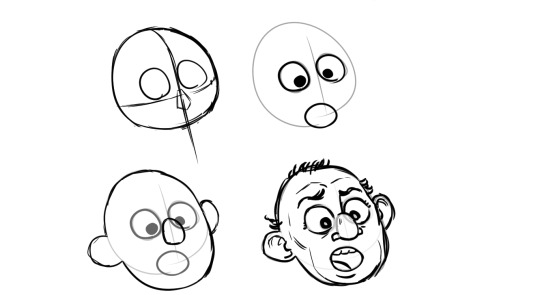
i start with a clear, well defined solid structure, i add whatever wacky cartoony features i want on top of it (none the less strongly tied and guided by the underlying structure) and then i refine by adding as many more realistic, grounding details i want, although you can go too far with it so i gotta be careful or ill end up with those shitty "cartoon character IRL would look scary!" clickbait drawings.

(quick aside, this trend fucking sucks, its obvious the artist went out of their way to make the drawing creepy, this pretension that "actually the character would look scary irl" deliberatly misundertands the principles of stylization, its as creatively bankrupt as jokes about mario eating mushrooms)
getting back on topic, the point is that, as long as the underlying structures are solid you can build whatever you want on top of them and it will make sense

a key tool here is internalizing the way the proportions on the face work. and i say internalize because obviously i dont actually have the golden ratio memorized inside my head nor do i stop and measure and calculate all the proportions in the features. i just read a lot about drawing, i drew a lot, i tried to always keep a critical eye to what im drawing and see if it "feels" disproportionate. once you get an eye for it then you know how far you can push things before they complitely break

let me give you another example of what i feel is a botched execution of this.

if you look closely at the face on the left there are a lot of things that dont make sense. the corners of the eyebrows dip down into the eyes when usually the eyes are enveloped by the eyebrows, the way the beard grows around the nose is just not how facial hair is distributed, the mouth is too big, etc. on the left i used photoshop to reorganize the factions into something that makes a bit more sense to me
(another quick aside, the real big problem at the heart of the original drawing were not so much the proportions but the tangents, when different lines touch each other like this that is usually a big no no but that is a topic for another day)
also a lot of it is just me cheating. yeah i cheat. you ever heard how people say there is no innate talent and its all practisce and hard work. well, yeah, that is mostly true, but is also true that some people are born with inherent advantages. either taller or more predisposed to being thin or with better facial structures or better innate hand-eye coordination. i was born with an uncanny capacity to visualize stuff. i have whatever the opposite of aphantasia is. i can borderline hallucinate things if i want to. and that goes coupled with the visual intuitions i developed through practisce and training.
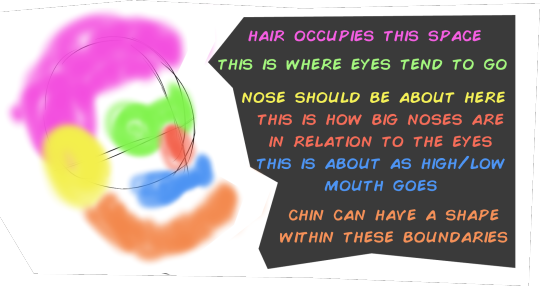
so first come the learned wisdom, and then comes the innate talent that helps me exploit that learned wisdom to its full potential
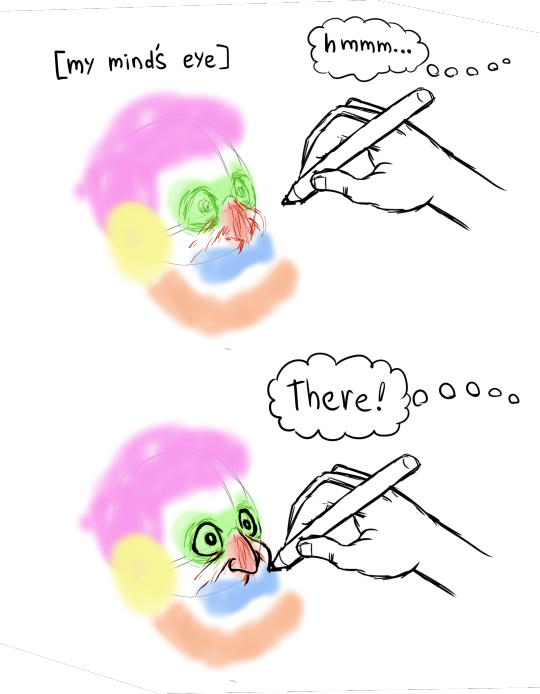
on top of that is corporeality, i try to draw in such a way that it conveys depth and weight to the things im drawing, certain kinds of stylizations dont care about that and choose instead to have their drawing look flat, a classic one is the UPA style

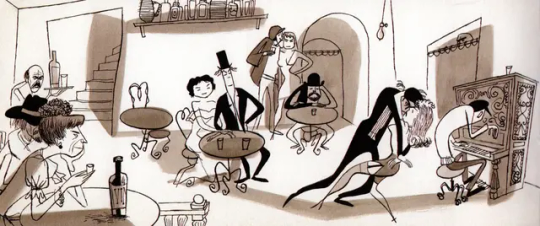

is a very fun style! very cute, very dynamic, very expressive in its simplicity. it became very popular in the 60's and 70's. personally i choose to go in a different direction. i draw in such a way that if one were to turn my drawings into 3d models not a lot would get lost in the process.
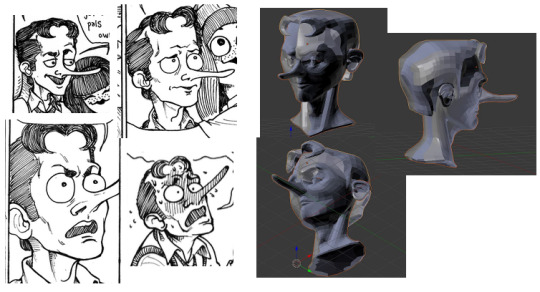
whereas other artists....

...not so much
but yeah, ultimatly it all goes back to underlying structure. any drawing can work

as long as you have a strong foundation underneath.
PS: if you like my style i cannot reccomend enough the art of @rezuaq i feel they follow a lot of the same principles i talked about here but i could be wrong.

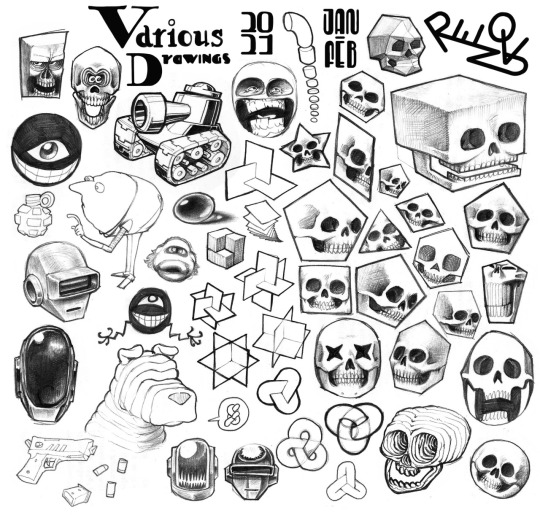
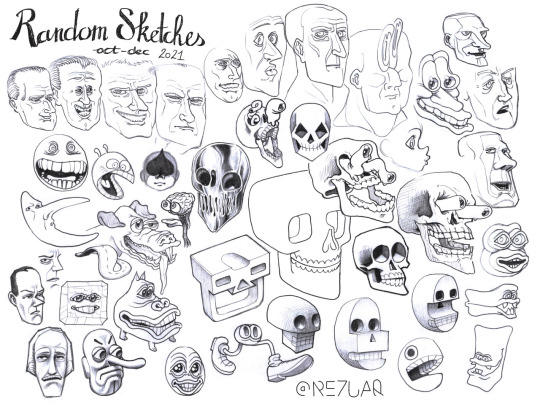
they have been my biggest inspiration as of the last 4 years, i shamelssly stole the design of one of their characters for jennyffer. go to their blog and give them a like
45 notes
·
View notes
Note
this is so random but do u have a headcannon that remus is bigger than james? bc i feel like i get that vibe from the gilded constellations writing. nothing wrong if u do ofc i just always thought with james being so devoted to quidditch he’d be kinda beefy (i also know a lot of other ppl hc him like that too in their writing so i’m used to it). just asking ofc cuz i wanted to make sure, no hate <333
Hey love! I definitely see Rem as the biggest, or well, at least the tallest. You see, Harry is kinda short, and while I do think James was taller than Harry, even taller than Sirius, I don't think he was taller than Rem.
Having said that, I do think James is the beefiest, or at least he has the most defined muscles between the boys, since, like you mentioned, he is a quidditch player (and crazy about it).
So, let's say Remus is as defined as Loki (from the series), and James is like Bucky from like the second movie, or maybe like Sam Winchester season 7 (I don't think he was as big as let's say Captain America for example)
As for Sirius, my shortest baby, I think he is also pretty well defined but more on the skinnier side, like Tobey Mcguire or Tom Holland when they played Spiderman.
Does that make sense?

Actually, scratch that, I decided to a mini google search for references and while my search history is now filled with shirtless dudes, I think I found a good deal of references for the body shapes I headcannon them as.
Side not: Tobey was freaking ripped when he did Spiderman? Like why do I remember him as chubby cute? Man was Beefy Cute!
Anyway, that would be my reference for Remus now.
Then I found a pic of Tom Hiddleston from Only Lovers Left Alive and it fit Sirius like a fucking glove.
Lastly, James, who I headcannon as the beefiest, would be about the size of Tom Hiddleston in that one Loki scene. Like especially back width wise, if that makes sense? I think James has a way sharper shoulder-to-waist ratio than the other two boys.
But, also sometimes I just see James as Aaron, so I just picture him exactly like he looked in Nowhere Boy lol. Or sometimes as Beefy as he was as Quick Silver, so it varies from fic to fic.
But Remus is 100% the tallest in my head.
#lilly talks#ask lilly#marauders era#marauders x reader#marauders x y/n#moony#padfoot#prongs#sirius black#sirius x reader#sirius black fluff#sirius x you#sirius x y/n#remus x y/n#remus x you#remus x reader#remus one shot#sirius black one shot#poly!marauders x reader#poly!marauders#wolfstar x reader#wolfstar x y/n#wolfstar x you#sirius black x fem!reader#remus lupin x fem!reader#moony x reader#moony x padfoot#moony wormtail padfoot and prongs#moony x you
28 notes
·
View notes
Text
If Your First Name Has These Letters…
Prominent letters: check the first letter, second letter, first vowel, last letter, most frequently occurring type of letters
Note: you relate to these characteristics if TWO letters out of the prominent letters are of the same following group or if a certain type (3 groups) of letter has the highest ratio, does that make sense?
A, D, G, J, M, P, S, V, Y: honest, can be easily confused, seen as aggressive, difficulties comforting people, noticeable body proportions especially their biceps and ass 🔥 flaunt it!, can be seen as happy, selfish, can have difficulties finding people that truly understand or relate to them, expect too much of people, accidentally coming across as rude and standoffish, people thinking you’re not the friendliest, can give off happy vibes, having basic common sense, generally reliable
Prominent examples: Sarah, Mark, Maddie, Maddison, Gabby, Yana, Vanessa, Jamie
B, E, H, K, N, Q, T, W, Z: can get along with everyone, has no problems being friends with any gender, has a keen understanding of science, commerce, and mathematics, efficient because they always figure out a way to execute a task with the lowest energy required 💪, sooooo intelligent, their way with words and style are on point, creative thinkings, unconventional/abstract thinkers, quick to learn, a lack of these letters may mean bad at/slow to learn math or quite bad at simple mental maths especially addition/subtraction, can be unreliable, prone to being an initiator/victim of gossip
Prominent examples: Ben, Teagan, Henry, Bella, Bethany, Neo, Weasley
C, F, I, L, O, R, U, X: skilled at expressing emotions, very emotional, people finding you so likable, people magnet, everyone getting along with you but you feel like you only get along with a handle of people, may have difficulties with academics, excellent at comforting people, high levels of empathy, interactive with their surroundings, knowing how to have a good time at a party
Prominent examples: Olivia, Lola, Coco, Ruby, Chris, Xiao-, Fiona, Lily
20 notes
·
View notes
Note
how do you avoid making a creature that's too similar to another?
Excellant question, because it’s a perfect occasion for me to discuss about diversity, a central theme in this serie, and how to illustrate it !!
The first method is creature design in its purest form : what does my creature looks like ? And then breakdown every aspect of what makes a monster. For anatomy i see 2 main parameters :
architecture : how many limbs ? heads ? and where to put them ? For example you can see “gryphons” as a kind of structure, with 4 legs, 2 wings and a beak (roughly) and play around with this structure
proportions : the same chimera with different proportions makes very different monsters ! You can play with the head/body ratio, make some limbs vestigial, or big wingspan to make them impressive, etc. For chimeras, this is the main difference between drawing and taxidermy !
Another aspect for my case with chimeras is which species i’m using. Unless i have a precise idea in mind i always make some quick research :
for example if i need a flamingo i check all the different kinds of flamingoes on wikipedia ; sometimes i go back up the phylogenic trees to see similar animals but slightly different
if i’m illustrating a monster from a precise geographic location i try to look for local species too, to make it more consistent
sometimes the design is based around a particular specie of animal i find interesting
i guess it goes with species, but you can obviously change patterns (on fur, wings etc) or colors (not my problem tho).
For example, lately i’m drawing Lemures where i combine bodies of lemurs with heads of larvae : the architecture is always the same but the possibilities are endless !
Second method is more concept-driven :
it’s how can i challenge definitions and concepts (whats is a dragon ?? seriously ???), try to explore it and cover all the range of the definitions and push them at their limits (ok now i have no idea what a dragon is anymore)
it can also start with a theme (what if i combine all the animals behind the symbols of the Seven Deadly Sins to make a chimeric representation?? what if that beach i went once 2 years ago were full of creatures ???), and it could be something very abstract (what if that music is actually about a monster ??)
you can also mix concepts together (metachimeras) !!
I also start from prompts (through asks, challenges and shittycryptids, mostly), because there are many ways to interprete them : sometimes i try to channel different inspirations by previous interpretations into one design, sometimes i just give what people wanted to see, but i have more fun when i respond exactly to the prompt in the most unpredictable way.

All of these methods bring a lot of diversity, and i will never run out of ideas ! The possibilities for chimeras are endless, and these are some methods i’ve got to find them. If you have other methods please share them !! And if you are interested by the methodologic aspect, i’ve done a masterpost that explain the tags for different categories and links to check the chimeras behind.
And also, most importantly maybe, but i try to leave some space for intuition : if something works or comes in my mind and it looks good i just go with it ! I always have a sketchbook for when i’ve got random ideas coming to me. Intellectualizing the process is fun, but creation isnt only about methodology.
#and this is only about design i havent talked about artstyle#i feel like that post is unreadable ahaha#ars chimera#ask#themarshmush#chimera#monster#creature design#bestiary
43 notes
·
View notes
Text
Howmhow - Platin
When it comes to converting measurements, understanding the relationship between different units is essential. One common conversion is from ounces to gallons. To convert ounces to gallons, it's important to know that 1 gallon is equivalent to 128 fluid ounces. Therefore, to convert any how many ounces in a gallon, simply divide the number of ounces by 128. For example, 2.67 ounces is equal to approximately 0.0208594 gallon [liquid]. This conversion is particularly useful when dealing with liquid volumes, such as in cooking or measuring liquids for various purposes. Having a conversion chart or cheat sheet can also be handy for quick reference. Another conversion that may come in handy is weeks to years. How many weeks in a year? To convert a measurement in weeks to a measurement in years, multiply the number of weeks by the conversion ratio of 0.019165 years/week. This conversion is useful when calculating time spans or determining someone's age in years based on the number of weeks. For example, if someone is 52 weeks old, they would be approximately 1 year old. Understanding this conversion can be helpful in various contexts, such as planning projects or tracking milestones. As the holiday season approaches, many people may wonder how many days until Christmas. The countdown to Christmas can be calculated by determining the number of days between the current date and Christmas Day. For example, if today is December 1st, there are 24 days until Christmas. Online calculators or countdown clocks can provide an accurate count of the remaining days. This countdown is often used to build excitement and anticipation for the holiday season, especially among children. It allows individuals to plan and prepare for festive celebrations and gift-giving. Additionally, knowing the exact number of days until Christmas can help with organizing schedules and completing tasks before the holiday arrives.
1K notes
·
View notes